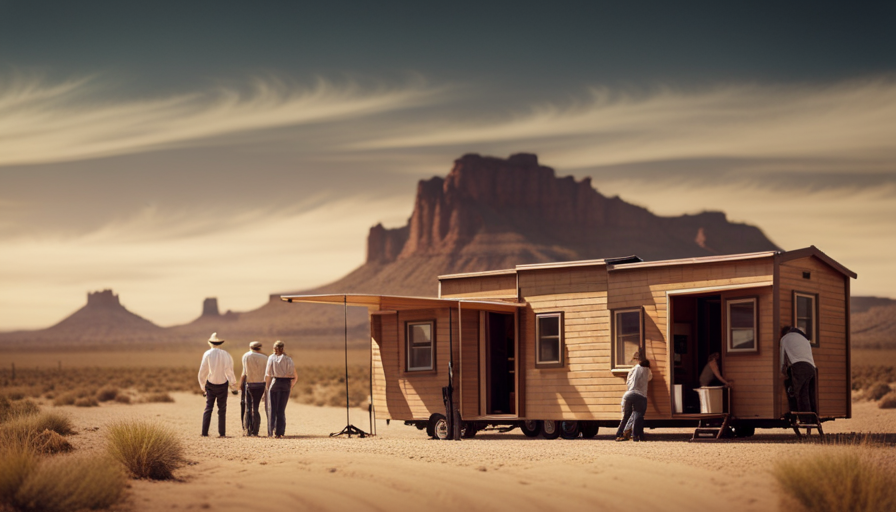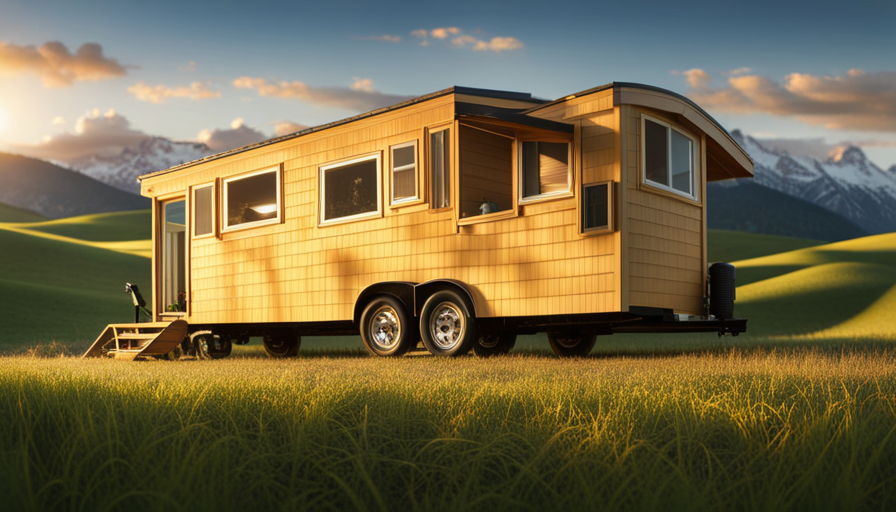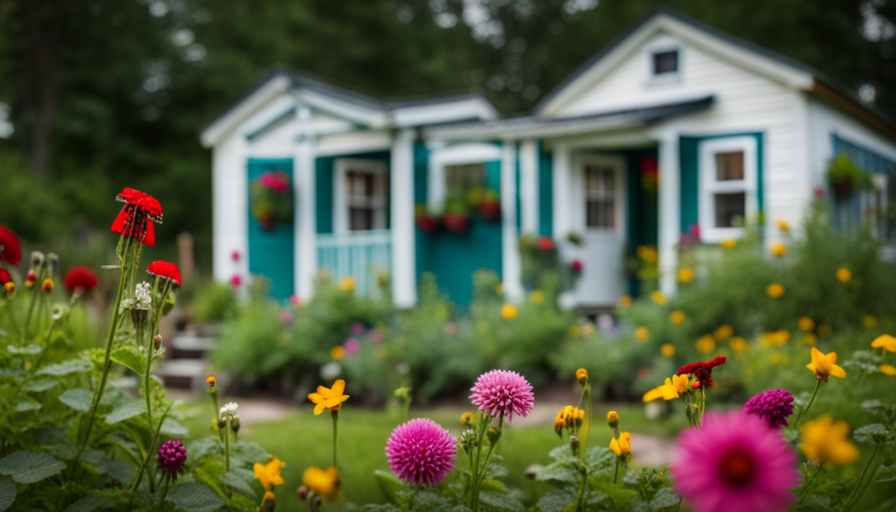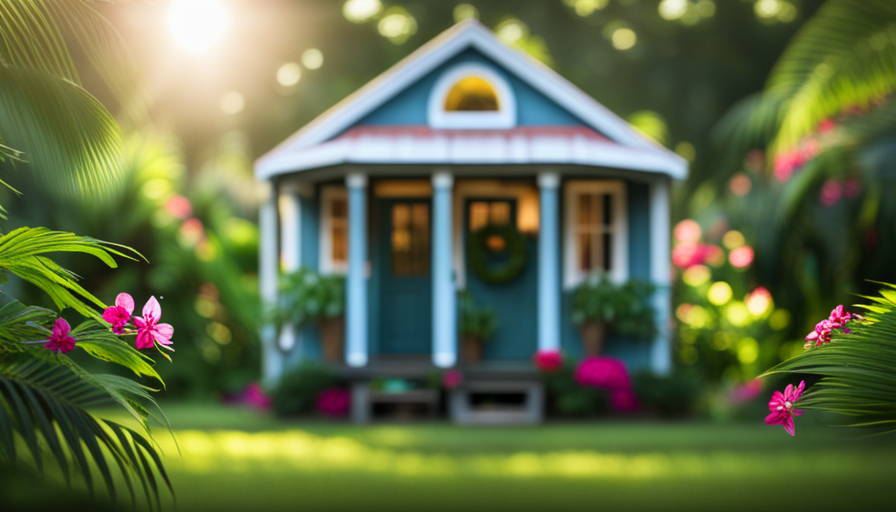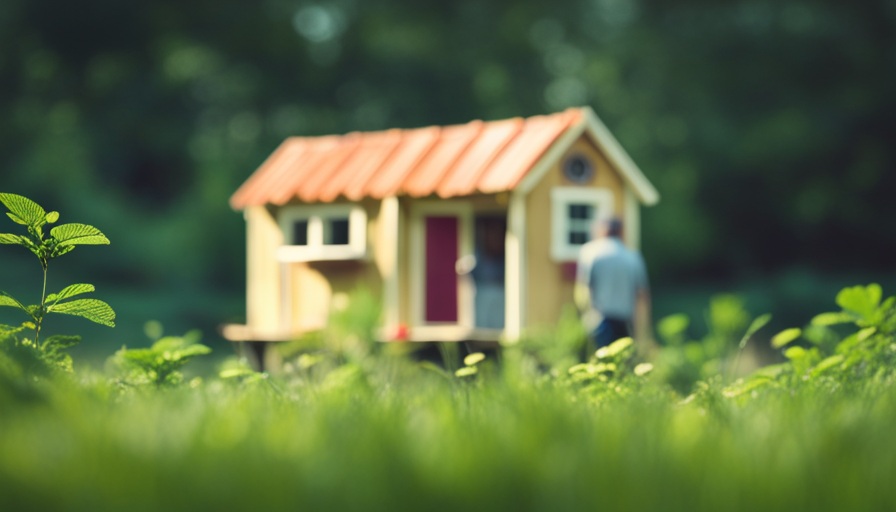Have you ever fantasized about residing in a snug and efficiently designed space, where every inch is tailored to cater to your requirements? If you are the happy owner of a tiny house, you understand the incredible experience it can offer.
But what happens when you want to move your tiny house to a new location? Don’t worry, I’ve got you covered. In this article, I’ll walk you through the step-by-step process of moving your tiny house, from assessing the feasibility to setting up your new home.
We’ll discuss how to plan your route, secure permits and insurance, and even how to pack and organize your belongings. And if you’re feeling overwhelmed, don’t fret – I’ll also share tips on hiring professional assistance.
So, whether you’re ready to embark on a new adventure or simply looking to change your scenery, get ready to learn everything you need to know about moving a tiny house. Let’s dive in!
Key Takeaways
- Feasibility and cost assessment are important before moving a tiny house.
- Hiring professional movers with experience is crucial for a successful move.
- Adequate preparation of the tiny house and careful packing of belongings are necessary.
- Reconnecting utilities and inspecting for damage after the move are essential steps.
Assess the Feasibility of Moving Your Tiny House
Moving your tiny house may not be as easy as you think, so it’s important to assess its feasibility before making any plans.
One key aspect to consider is the cost involved in moving your tiny house. Assessing costs will help you determine if it’s financially viable to move your house or if it would be more practical to sell it and build a new one at your desired location.
Additionally, finding professional movers who have experience in moving tiny houses is crucial. They’ll have the expertise and equipment necessary to handle your house safely and efficiently.
Once you’ve assessed the feasibility and determined that moving is the best option, it’s time to plan your route and transportation. This involves mapping out the most suitable roads and highways and making arrangements for the transportation of your tiny house.
Plan Your Route and Transportation
Navigating your route and arranging transportation are key steps in ensuring a smooth and exciting journey for your cozy abode on wheels. When planning your route, consider the size of your tiny house and any potential obstacles, such as low bridges or narrow roads. Plan logistics by mapping out the most efficient and safest route, taking into account fuel stations and rest stops along the way.
It’s important to choose the right transportation for your tiny house. Options include hiring a professional moving company with experience in transporting tiny houses or using a flatbed trailer or a tow vehicle. Whichever option you choose, make sure the transportation method is suitable for the size and weight of your tiny house.
By carefully planning your route and choosing the right transportation, you can ensure a successful move for your tiny house.
Now, let’s explore the next step: securing permits and insurance.
Secure Permits and Insurance
Once you’ve planned your route and chosen the right transportation, it’s time to buckle up and ensure a smooth journey by securing the necessary permits and insurance. Just like strapping on your seatbelt before embarking on a roller coaster ride.
To move a tiny house, you need to obtain necessary permits from the local authorities. These permits may include a wide load permit, which allows you to transport your tiny house on the road, and any other permits required by your specific route or destination.
It’s crucial to obtain proper insurance coverage for your tiny house during the move. This will protect you from any potential damages or accidents that may occur.
With the permits and insurance in place, you can now confidently prepare your tiny house for the move, ensuring it is well-equipped for the journey ahead.
Prepare Your Tiny House for the Move
Ensure that you’ve adequately prepared your compact dwelling for transportation by taking the necessary steps to secure it for the journey ahead.
One important aspect to consider is choosing the right towing vehicle. Make sure to select a vehicle that has the appropriate towing capacity and is compatible with your tiny house’s weight and dimensions.
Additionally, it’s crucial to secure all furniture and decor inside your tiny house to prevent any damage during the move. Use straps, bungee cords, or other securing devices to hold everything in place.
Remove any fragile or valuable items and pack them separately to ensure their safety. By properly securing your belongings and choosing the right towing vehicle, you can minimize the risk of damage during transportation.
Once your tiny house is fully prepared, it’s time to consider hiring professional assistance for the move.
Hire Professional Assistance
By enlisting the help of experienced movers, you can entrust the intricacies of your miniature abode to skilled hands, allowing you to embark on this transformative journey with peace of mind.
Hiring professional movers is crucial when it comes to moving a tiny house. These experts have the knowledge and experience to handle the unique challenges that come with transporting a tiny house safely and efficiently. They will ensure that your tiny house is securely loaded onto a trailer or truck, taking into account weight distribution and structural integrity.
Additionally, professional movers can provide you with a cost estimation for the move, taking into consideration factors such as distance, size of the tiny house, and any additional services required. With their expertise, you can rest assured that your tiny house will be in good hands throughout the moving process.
Once you’ve hired professional assistance, the next step is to disconnect utilities and secure your tiny house…
Disconnect Utilities and Secure Your Tiny House
When disconnecting utilities and securing your tiny house, you’ll want to take extra precautions to ensure a smooth transition and protect your valuable investment.
Start by contacting your utility providers to schedule the disconnection of services such as electricity, water, and gas. It’s important to follow their guidelines and ensure that all connections are properly shut off to avoid any potential hazards during transport.
Next, secure your belongings inside the tiny house to prevent any damage during the move. Secure loose items, such as furniture and appliances, by using straps or bungee cords to keep them in place. Remove any fragile or valuable items and pack them separately to ensure their safety. Don’t forget to lock all doors and windows to prevent any unwanted access during the move.
Now that your utilities are disconnected and your belongings are secured, you can move on to the next step: pack and organize your belongings for the move.
Pack and Organize Your Belongings
Start by carefully packing and organizing your belongings, creating a well-orchestrated puzzle of boxes and furniture that fits perfectly together in the limited space available. To make the most of your tiny house move, here are some organizing tips and packing supplies you should consider:
| Organizing Tips | Packing Supplies |
|---|---|
| Use clear plastic bins | Bubble wrap |
| Label each box | Packing tape |
| Pack heavy items at the bottom | Furniture blankets |
| Disassemble furniture | Stretch wrap |
| Use vacuum-sealed bags | Moving boxes |
By following these tips and using the right packing supplies, you can ensure that your belongings are protected and efficiently packed. Once everything is organized, it’s time to safely transport your tiny house to its new location.
Safely Transport Your Tiny House
Now that you’ve packed and organized your belongings, it’s time to safely transport your tiny house to its new location.
When it comes to towing a tiny house, there are a few important tips to keep in mind. First, make sure to choose the right vehicle for the job. You’ll need a truck or SUV with enough towing capacity to handle the weight of your tiny house.
Additionally, consider investing in a weight distribution hitch and sway control system to ensure a smooth and stable ride.
Before hitting the road, double-check that all doors, windows, and cabinets are securely closed and latched. It’s also a good idea to remove any loose items inside the house to prevent damage during transport.
With these tiny house towing tips in mind, you’ll be well-prepared to move your home to its new destination.
So let’s dive into the next step: setting up your tiny house in the new location.
Set Up Your Tiny House in the New Location
When setting up your tiny house in a new location, it’s important to first level and stabilize the house to ensure safety and comfort. This can be done by using leveling jacks or blocks to adjust the height and make sure the house is sitting evenly on the ground.
Once the house is level, it’s crucial to reconnect utilities such as water, electricity, and sewage.
Finally, it’s essential to inspect the house for any damage that may have occurred during the move, such as cracks in the foundation or leaks in the plumbing.
By taking these steps, you can ensure a smooth transition and a well-functioning tiny house in its new location.
Level and stabilize your tiny house
To ensure a safe and secure journey, it’s crucial to level and stabilize your tiny house before moving it. Assessing the stability of your tiny house is the first step in this process. Look for any signs of structural damage or weak points that may affect its stability during transportation. Once you have assessed the stability, you can proceed with leveling techniques. This involves using leveling jacks or blocks to ensure that your tiny house is perfectly level on all sides. This will prevent any shifting or tilting while it’s being moved.
To evoke an emotional response in the audience, consider the following table:
| Stability Assessment | Leveling Techniques |
|---|---|
| Inspect for damages | Use leveling jacks |
| Check for weak points | Utilize leveling blocks |
| Reinforce any areas of concern | Ensure perfect levelness |
By following these steps, you can guarantee that your tiny house will stay secure during transportation. Once your tiny house is level and stable, you can proceed to the next step: reconnecting utilities and inspecting for any damage during the move.
Reconnect utilities and inspect for any damage during the move
After ensuring the stability and levelness of my tiny house, it’s time to reconnect the utilities and check for any damage that may have occurred during transportation.
Reconnecting the utilities is crucial to ensure that my tiny house is fully functional and ready for me to live in. I start by reconnecting the electrical system, making sure to follow all safety protocols.
Next, I reconnect the plumbing system, checking for any leaks or damages.
Once the utilities are up and running, I carefully inspect my tiny house for any signs of damage caused by the move. This includes checking for cracks, loose fittings, or any other issues that may have arisen during transportation.
It’s important to address any damages promptly to prevent further problems down the line.
With the utilities reconnected and the damage assessed, I can now move on to the exciting part – enjoying my new home!
Enjoy Your New Home!
Now that I’ve successfully moved my tiny house to a new location, it’s time to enjoy my new home!
I’m going to take some time to settle in and personalize my space, making it truly my own. From choosing the right furniture to adding personal touches, I’m excited to create a cozy and inviting atmosphere.
Additionally, I can’t wait to explore the new opportunities that my new location has to offer. Whether it’s discovering local attractions, joining community events, or connecting with new neighbors, I’m ready to embrace everything this new chapter has in store for me.
Take some time to settle in and personalize your space
Once you’ve gotten settled in and made your tiny house feel like home, it’s time to let your creativity run wild and turn it into a space that truly reflects your unique personality.
Personalizing your tiny house is an exciting part of the settling process, and here are a few tips to help you make it your own:
-
Choose a color scheme that resonates with you and paint the walls accordingly. This can instantly transform the look and feel of your space.
-
Add personal touches through artwork, photographs, and decorative items. Displaying things that hold sentimental value will make your tiny house feel warm and inviting.
-
Make the most of your storage options by organizing your belongings in a way that suits your needs and lifestyle.
After settling in and personalizing your tiny house, it’s time to explore and embrace the new opportunities in your new location.
Explore and embrace the new opportunities in your new location
Discover the endless possibilities and embrace all the exciting opportunities awaiting you in this new and vibrant location. Moving to a new place isn’t just about the physical relocation, but also about the chance to explore and connect with the local community.
Take this opportunity to discover the hidden gems and explore the local attractions that make this place unique. From parks and museums to restaurants and shops, there’s so much to see and experience.
Engaging with the community won’t only help you feel more at home but also open doors to new friendships and opportunities. Attend local events, join clubs or organizations, and get involved in community projects.
Embrace the new opportunities and make the most of this exciting new chapter in your life.
Frequently Asked Questions
How much does it cost to hire professional assistance for moving a tiny house?
Hiring professional movers can vary in cost depending on several factors such as the distance, size, and complexity of the move. On average, the cost of professional assistance for moving a tiny house can range from $1,000 to $5,000.
However, if you’re looking for a more budget-friendly option, you could consider the do-it-yourself (DIY) approach. DIY options may involve renting a moving truck, gathering a few friends, and tackling the move yourself, which can significantly reduce the cost.
Are there any restrictions or regulations on moving a tiny house across state lines?
There are indeed restrictions and regulations when it comes to moving a tiny house across state lines. Each state has its own set of rules regarding the transportation of oversized loads, and it’s essential to comply with them.
Additionally, insurance requirements for moving a tiny house on a trailer also vary by state. To ensure a smooth and legal move, it’s crucial to research and understand the specific restrictions and insurance requirements of both the departure and destination states.
What are some common challenges or obstacles that may arise during the transportation of a tiny house?
Ah, the joys of transporting a tiny house. Let me enlighten you on the common challenges and obstacles that can make this experience oh so delightful.
First and foremost, we have the joy of navigating narrow roads and tight turns, testing our driving skills to the max.
Then there’s the fun of dealing with weight restrictions and permits, like a never-ending game of bureaucratic hoops.
And let’s not forget the thrill of securing the house properly to avoid any unexpected detours.
Transporting a tiny house, it’s an adventure like no other.
What steps should I take to protect my belongings from damage during the move?
To protect my belongings during a move, I take several steps. Firstly, I carefully pack fragile items using bubble wrap or packing paper. I secure them with tape and place them in sturdy boxes.
I also label these boxes as ‘fragile’ to ensure they receive special attention during the move. Additionally, I use furniture pads or blankets to protect larger items from scratches or damage.
Finally, I double-check that everything is securely packed and loaded before the move.
Are there any specific permits or insurance requirements for moving a tiny house on a trailer?
Moving a tiny house on a trailer can be a bit like navigating a maze. Permits and insurance requirements are crucial.
Before hitting the road, check with local authorities to ensure you have the necessary permits. As for insurance, it’s essential to protect your investment.
Challenge-wise, narrow roads and low bridges can be tricky, so plan your route carefully. Additionally, take measures like securing furniture and fragile items to prevent damage during transit.
Conclusion
In conclusion, moving a tiny house may seem like a daunting task, but with careful planning and professional assistance, it can be a smooth and successful endeavor.
Remember to assess the feasibility of the move, plan your route, secure permits and insurance, and prepare your tiny house for transportation.
Pack and organize your belongings, ensuring their safety during the move.
Finally, set up your tiny house in the new location and savor the sweet taste of success. After all, as the saying goes, "Home is where the heart is," and with your tiny house in its new spot, your heart will surely be content.
Hi, I’m Emma. I’m the Editor in Chief of Tiny House 43, a blog all about tiny houses. While tree houses are often associated with childhood, they can be the perfect adult retreat. They offer a cozy space to relax and unwind, surrounded by nature. And since they’re typically built on stilts or raised platforms, they offer stunning views that traditional homes simply can’t match. If you’re looking for a unique and romantic getaway, a tree house tiny house might just be the perfect option.
